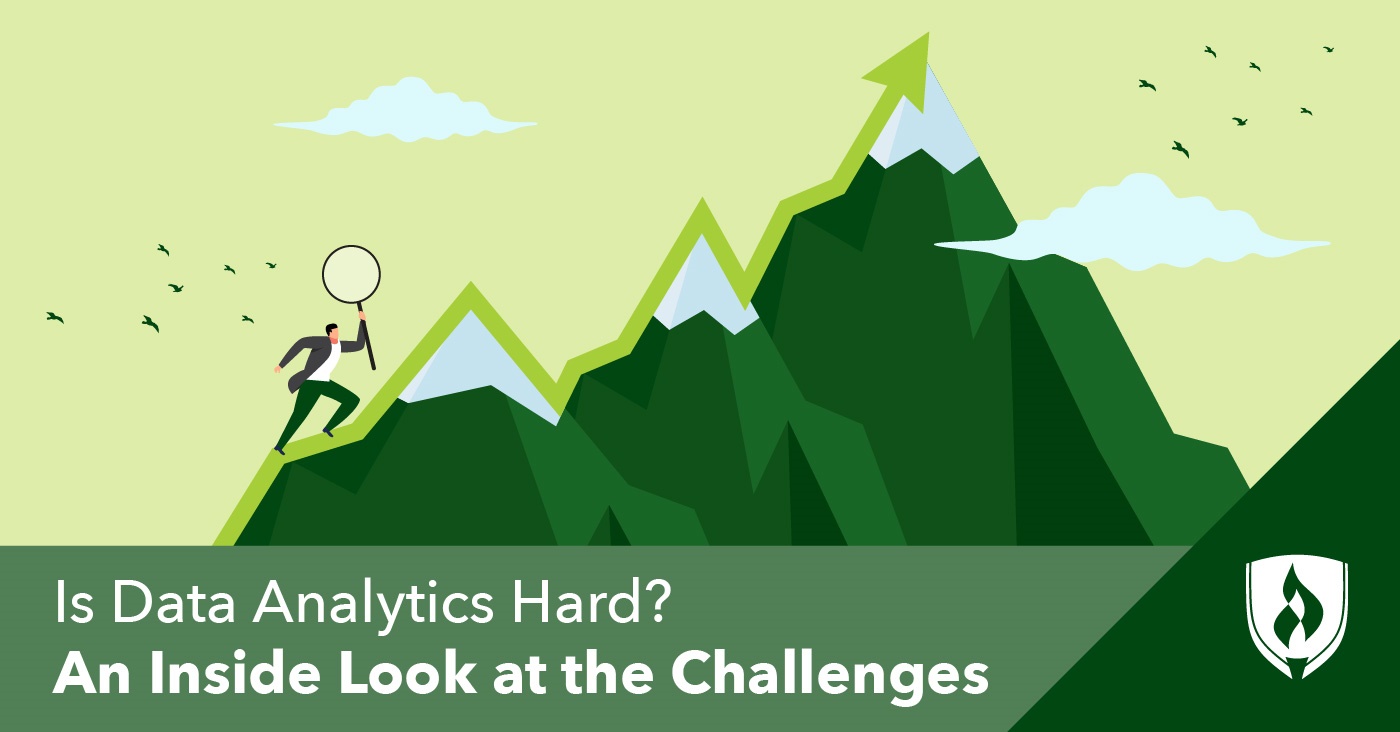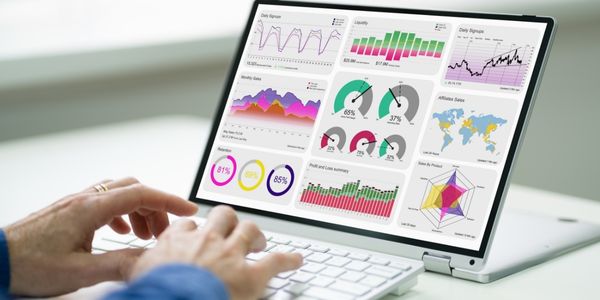
If you had a dollar for every time you bumped into the term analytics—you’d be rich by now. It seems that every organization, from energy companies to online shoe retailers, is obsessed with tracking data and turning it into meaningful insights. The reasons for this are pretty obvious—what organization wouldn’t want to know if their marketing efforts were effective or if their new business process improved profitability?
Despite the prevalence of tools for tracking and sorting data, the sheer volume of information available demands dedicated professionals who can work with massive data sets, create ways to pull in the right kind of information in the first place and then ensure the data quality and potential insights allow for meaningful choices.
You might be thinking that data analytics sounds complex—and you’d be right! But data analysis skills can also be a ticket to a solid career.
More and more companies are turning to big data and data analytics to help pave their path forward, and those companies need skilled data professionals to make it happen.1 These interesting roles require training and plenty of continuous learning, leading many to wonder: Is data analytics hard?
That’s a very personal question that only individuals can answer for themselves. But to help you gauge the level of difficulty in this field, we asked data analytics professionals to share some of the most challenging aspects of learning and working in data. Read on to see what these experts believe to be the hardest aspects of a career in data analytics and how they navigated through these challenges.
Is learning data analytics hard? Common challenges for getting started
There’s a difference between the challenges of learning the foundational skills needed to get started as a data analyst and the challenges that come with the day-to-day work. Let’s start with what these data professionals found to be tricky as they were just learning the ropes.
1. Information overload is likely
While the irony of initially feeling like you have too much information to process to work in a career focused on processing huge amounts of data shouldn’t be lost, it’s still a common feeling.
The amount of knowledge and information you’ll need to succeed in data analytics can definitely feel daunting early on, according to Kenny Warner, data scientist at meez®. Many data analytics programs teach conceptual knowledge and principles while also getting into tools, practices and hard skills—that can be a lot if you’re not ready for it.
“In each class, I was being taught a different programming language or software,” says Steven Johnson, data community advocate at Shipyard®. “As someone who was new to this world, I was still trying to establish conceptual knowledge of analytics. However, I was then asked to transition concepts that were still foreign to me to multiple different tools or languages.”
The good news is that most people in the field know this overwhelming nature of knowledge well.
“If you are feeling out of your depth, just know that you are not alone,” Warner says. He explains that even after a decade in the industry, he’s still amazed by how many things you can learn. To make progress, he suggests choosing one thing at a time and working with it until you really understand it. Figure out how it was developed and why. Figure out how people use it. “Once you have a good grasp on that topic, move on to the next one that you find interesting.”
2. Understanding when and why to use particular techniques takes time
“The area I found most difficult when starting out was understanding the ‘why’ behind the different techniques, algorithms and statistics that were used to solve a particular problem,” Warner says. He explains that there are lots of tools that allow you to plug in details, write a little code and generally make the process a bit easier. But knowing when to use a particular tool and which problems it’s better for will take more time.
“Understanding when you should use chi-squared versus Cramér's V versus ANOVA tests or logistic regression versus support vector machines versus random forests takes a more thorough knowledge base.” Warner says this is crucial in the long run to ensure you are getting the appropriate answer for the data you analyze.
3. Learning to quantify success for open-ended projects
In school, many data analytics professionals take on projects as they practice applying what they’ve learned. Sometimes, these projects are assignments with clear parameters and objectives. Other times, they are more self-driven, pushing students to solve problems or find information on their own.
“Being fed problems or projects that have well-defined outcomes and clean data is great for starting out,” Warner says. “However, the sooner you can move on to projects that don’t have ‘correct’ answers, where you have to define the problem and identify success yourself, the more and faster you will learn.”
You might think of data analysis as a field full of questions that are directly answered with hard, quantifiable data that provides clear direction. While those questions certainly exist, there are also a lot of questions or scenarios with gray areas to navigate and hard-to-quantify factors that may influence an analysis. Thinking through it all takes practice—and you shouldn’t hesitate to ask instructors or more experienced data professionals for their point of view.
Is being a data analyst hard? Challenges you’ll find in the day-to-day work
Once you’ve learned some of the foundational concepts and skills and are working in a data analytics role, what types of challenges can you expect?
1. Applying and explaining technical skill in a business environment
Data analysts exist to help companies derive useful information from masses of data that most people would consider gibberish. When you step into this role, you are becoming a sort of translator, bridging the world of data to the world of business.
“When I entered the field, I was under the impression that I would spend my time developing complex machine learning models for analysis,” Warner says. In reality, the tasks often don’t require a machine learning model, he explains. “I had to break down the complex technology to a scale where everyone sitting in the room can understand what is happening, why it is happening and what needs to be done.”
Learning how to answer those three “W questions” for the average listener was the most challenging part of beginning this career, Warner says.
2. Adapting to specific business tools and systems
“My college program did a great job of teaching me concepts and how to run models and work with data that was on my device,” Johnson says. But when it came to making all those things happen in the cloud, that was another story. “Understanding how to create business intelligence dashboards or write a machine learning model is great; however, hosting these items in the cloud and being able to use them to solve your stakeholder’s needs is what will allow you to generate value for your company as you begin your career.”
While your education and training will likely incorporate a lot of the same tools and systems organizations use, there can still be a learning curve as you apply what you know to legacy systems or tools that might not be a perfect one-to-one match with what you’ve learned in coursework. The fundamentals still apply, but it might take some additional figuring out before you’ll feel comfortable.
3. Cleaning and streamlining data
“The most challenging thing in my work today is constantly ensuring you have the necessary data in the necessary form for your particular task,” Warner says. The phrase “garbage in, garbage out” sums it up—an analysis of sloppy and poorly formatted data will lead to equally messy outputs.
It’s not the most glamorous part of the job, but the extract, transform and load (ETL) process is a critical—and sometimes challenging—step. Warner says taking the time to ensure efficient data pipelines, normalized data and high-accuracy inputs will ultimately make your analysis work easier and more meaningful.
4. Maintaining an appetite for continued learning
Whether you’re picking up new platforms or languages that can help improve your process or learning more about the details of the industry you’re supporting, there’s always more to master in a data analysis career. Keeping up with it all can be a challenge, but those who are inquisitive and enjoy learning are certainly valued.
“Be humble and understand that not knowing everything is okay and expected,” Johnson says. “In my experience, companies are much more interested in you telling the truth on what you [don’t] know than trying to act like you do know.”
Johnson says his first job interview involved several questions he didn’t know the answer to. While that’s certainly not a great feeling in the moment, Johnson says his decision to be honest and acknowledge shortcomings with a good attitude paid off as he still ended up landing the job.
“I asked my manager why they chose me over more qualified candidates, and she told me that the team knew I was not as experienced, but they could tell that I was eager to learn.”
What would challenge you?
Data analytics involves plenty of challenges and new things to learn. For the right person, that’s part of the fun! If you find these careers interesting, you might want to consider learning more about the field. Our article “Is a Data Analyst Career Right for Me? What You Should Consider” highlights some additional questions you should ask yourself before diving in. Ready to pursue your degree? Check out everything you need to know about Rasmussen's data analytics program.
1Louis Columbus, “53% Of Companies Are Adopting Big Data Analytics,” Forbes, December 24, 2017. [Accessed May 2022], https://www.forbes.com/sites/louiscolumbus/2017/12/24/53-of-companies-are-adopting-big-data-analytics/.
Meez is a registered trademark of Meez Culinary Solutions, LLC.
Shipyard is a registered trademark of Shipyard Build, Inc




